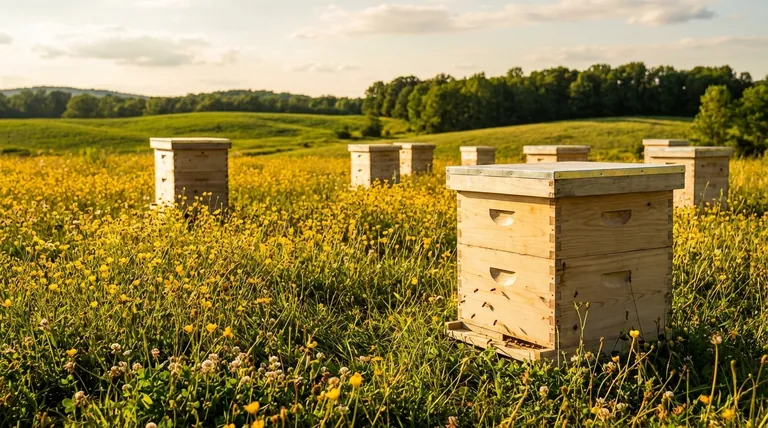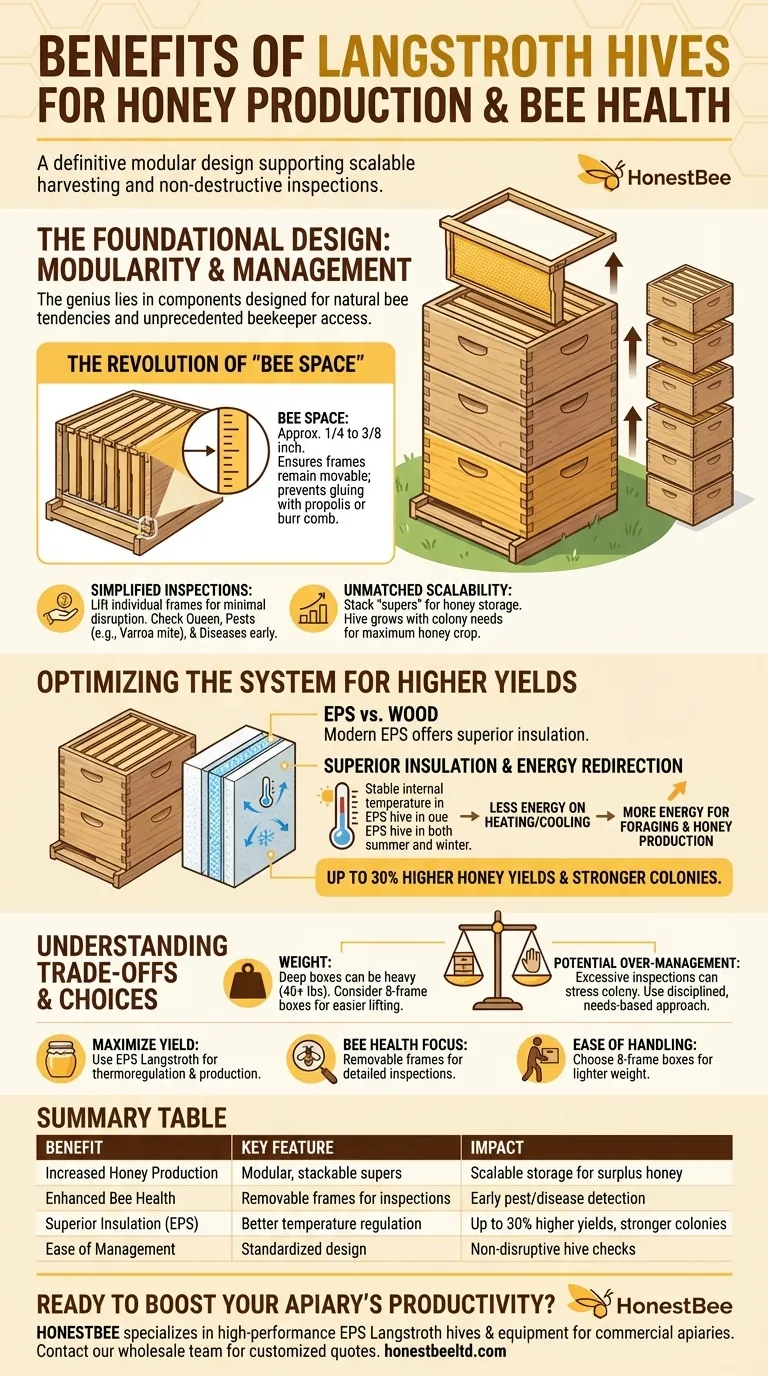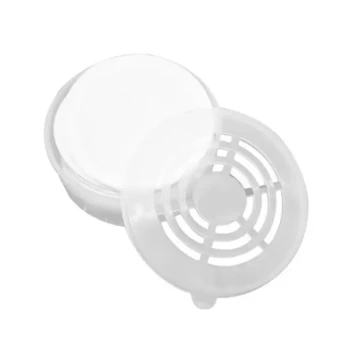The definitive benefit of a Langstroth hive is its modular design, which directly supports both honey production and bee health. Its system of vertically stackable boxes and individually removable frames has become the global standard for beekeeping precisely because it allows for scalable honey harvesting and non-destructive colony inspections.
The core advantage of the Langstroth hive is not the box itself, but the principle of "bee space." This innovation created a standardized, manageable system that gives the beekeeper direct control over colony health and honey production in a way no previous design could.

The Foundational Design: Modularity and Management
The genius of the Langstroth hive lies in its core components, which are designed to work with the natural tendencies of honey bees while giving the beekeeper unprecedented access.
The Revolution of "Bee Space"
The entire system is built around the precise measurement known as bee space. This is the gap (roughly 1/4 to 3/8 of an inch) that bees naturally leave between their combs.
By building the hive boxes and frames to respect this space, the Langstroth design ensures that bees will not glue the components together with propolis or build excess burr comb. This makes every frame movable and every box separable.
Simplified and Less Intrusive Inspections
Because each frame can be lifted out individually, a beekeeper can assess the health of a colony with minimal disruption.
You can easily check the queen's egg-laying pattern, look for signs of pests like the Varroa mite, and identify diseases early. This ability to perform detailed inspections without destroying the bees' comb is crucial for maintaining a healthy, thriving colony.
Unmatched Scalability for Honey Production
The Langstroth hive's size is limited only by how many boxes you are willing to stack. As the colony expands and a nectar flow begins, you can add more boxes, called "supers," specifically for honey storage.
This vertical modularity allows the hive to grow with the colony's needs, maximizing its potential to produce a surplus honey crop. This is a significant advantage for any beekeeper, from hobbyist to commercial operator.
Optimizing the System for Higher Yields
While the Langstroth design is the standard, the material it is made from can significantly impact its performance, particularly regarding honey production.
The Impact of Material Choice
Traditionally, Langstroth hives are made of wood. However, modern materials like high-density Expanded Polystyrene (EPS) offer distinct advantages.
Superior Insulation with EPS
EPS provides significantly better insulation than wood. This helps the bee colony regulate its internal temperature more efficiently, protecting them from extreme heat in the summer and cold in the winter.
Redirecting Colony Energy to Honey Stores
A colony that spends less energy on heating or cooling itself can dedicate more of its workforce to foraging for nectar and producing honey.
Well-insulated EPS hives can reduce a colony's energy consumption, which has been reported to boost honey yields by as much as 30%. This extra energy also contributes to a stronger, healthier colony overall.
Understanding the Trade-offs
No system is perfect, and the Langstroth hive's advantages come with practical considerations that are important for every beekeeper to understand.
Weight and Standardization
The biggest drawback is weight. A deep Langstroth box full of bees, brood, and honey can be very heavy, and a super full of honey can weigh 40 lbs or more. This can be a physical challenge for some beekeepers.
Potential for Over-Management
The ease of inspection can sometimes tempt beekeepers to open the hive too frequently. Unnecessary inspections can chill the brood and stress the colony, setting back its progress. A disciplined, needs-based approach is essential.
Making the Right Choice for Your Goal
Ultimately, the Langstroth hive provides a powerful and adaptable framework for managing honey bees. Your specific goals should guide how you utilize it.
- If your primary focus is maximizing honey yield: A Langstroth hive is the proven standard, and using an EPS version can further increase production by improving thermoregulation.
- If your primary focus is bee health and easy management: The removable frames of the Langstroth system are unparalleled for conducting the detailed inspections necessary to combat pests and disease.
- If you are concerned about lifting heavy equipment: Consider using 8-frame Langstroth boxes instead of the standard 10-frame, as they are lighter and easier to handle when full.
By understanding these core principles, you can effectively use the Langstroth system to support healthy colonies and achieve a successful honey harvest.
Summary Table:
| Benefit | Key Feature | Impact |
|---|---|---|
| Increased Honey Production | Modular, stackable supers | Scalable storage for surplus honey |
| Enhanced Bee Health | Removable frames for inspections | Early pest/disease detection |
| Superior Insulation (EPS) | Better temperature regulation | Up to 30% higher yields, stronger colonies |
| Ease of Management | Standardized design | Non-disruptive hive checks |
Ready to boost your apiary's productivity and honey yields?
At HONESTBEE, we specialize in supplying high-performance Langstroth hives and beekeeping equipment to commercial apiaries and distributors. Our durable, well-insulated EPS hives are designed to maximize honey production and support colony health.
Let us help you scale your operations efficiently. Contact our wholesale team today to discuss your equipment needs and receive a customized quote.
Visual Guide

Related Products
- Langstroth Bee Hives Bee Keeping Box for Beginners Beekeeping
- Long Langstroth Style Horizontal Top Bar Hive for Wholesale
- HONESTBEE Advanced Ergonomic Stainless Steel Hive Tool for Beekeeping
- Wholesales Dadant Size Wooden Bee Hives for Beekeeping
- Professional Dual-End Stainless Steel Hive Tool for Beekeeping
People Also Ask
- Why were wooden hives traditionally preferred? For Natural Beekeeping Aligned with Bee Biology
- Why might a beginner be advised to start with a Langstroth hive? Unlock a Supportive Beekeeping Ecosystem
- What basic equipment is needed to start beekeeping? Your Essential Guide to a Confident Start
- How does the orientation of the hive sides benefit comb construction? Ensure Straight, Movable Combs for Easier Hive Management
- Why are Langstroth hives recommended for beginners? Unmatched Support & Standardization



















